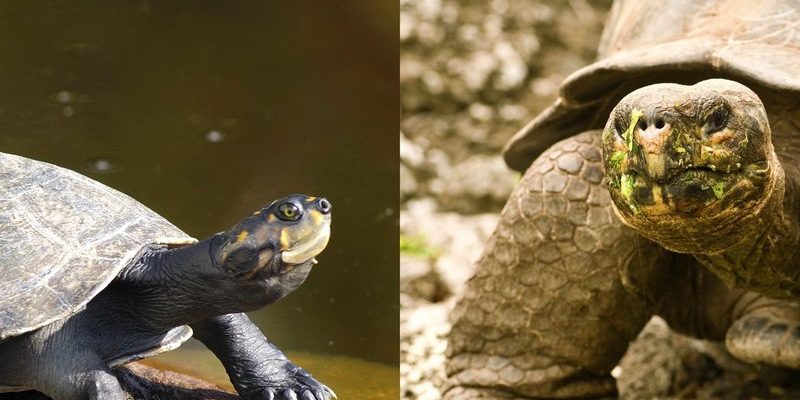![Turtle Vs. [Similar Species] - How They Compare](https://gudri.com/wp-content/uploads/2025/06/Turtle_Vs___Similar_Species____How_They_Compare_image_0.jpg)
So, why does it matter? Understanding the differences between turtles and tortoises can help us appreciate their unique roles in the ecosystem, as well as care for them better if you ever decide to keep one as a pet. Let’s dive deeper into the world of these fascinating reptiles.
One of the first things you’ll notice when comparing turtles and tortoises is their physical appearance. Turtles tend to have flatter, more streamlined shells, which make them great swimmers. Think of a turtle’s shell as a sleek little boat. Meanwhile, tortoises sport more rounded, dome-like shells that are designed for land travel. This shape provides them extra protection from predators.
Additionally, size differences come into play. Most turtles are smaller than tortoises, but there are exceptions. Some species of turtles can grow quite large, while tortoises like the Galápagos giant tortoise are among the largest reptiles on Earth. When you see these creatures side by side, it’s easy to see how their bodies are adapted for their lifestyles.
Turtles and tortoises also differ in terms of habitat. Turtles are aquatic or semi-aquatic animals. They thrive in water, whether it’s oceans, lakes, or rivers. Their life in the water influences their behavior and feeding habits. You might see a turtle sunbathing on a rock, but it’s likely right by the water’s edge, ready to dive in at a moment’s notice.
On the flip side, tortoises are strictly land-dwellers. They prefer dry, arid environments such as deserts or grasslands. Their bodies are built to conserve water, which is crucial for surviving in such habitats. Imagine a tortoise slowly meandering through the desert, solidly built against the harsh sun and sandy terrain.
When it comes to diet, turtles and tortoises have distinct preferences. Turtles are often omnivores, meaning they eat both plant and animal matter. Their diet can include aquatic plants, insects, small fish, and even crustaceans. If you’ve ever seen a turtle munching on a piece of lettuce at a pet store, you know their eating habits can be quite varied.
In contrast, tortoises are primarily herbivores. Their diet consists mainly of grasses, leafy greens, and fruits. Because tortoises are on land, they often graze for food throughout the day. Their plant-based diet is crucial for sustaining their health, given their slower metabolism. Think of a tortoise as a gentle garden muncher, always on the lookout for the freshest greens.
When we talk about behavior, turtles and tortoises exhibit some interesting differences. Turtles are often more social creatures. They can be seen basking in large groups—after all, there’s safety in numbers. Their playful nature can also lead to some amusing interactions, especially in the water where they’re more agile.
Tortoises, on the other hand, tend to be a bit more solitary. They are known for being more docile and slow-paced, often enjoying the quiet of their environment. This doesn’t mean they aren’t affectionate; pet tortoises can form bonds with their owners, but they enjoy their personal space. Imagine a tortoise slowly wandering around its yard, savoring each moment, contrasted with a turtle splashing around with its buddies.
Another fascinating area to explore is reproduction. Both turtles and tortoises lay eggs, but their nesting habits differ slightly. Turtles typically lay their eggs on land but near water. A mother turtle will dig a nest and lay her eggs, then leave them to incubate in the warm sand. Depending on the species, it can take several weeks to months for the eggs to hatch.
Tortoises also dig nests for their eggs, but they often choose different locations. They may dig burrows in the ground or use soft, sandy areas. The key difference is that tortoises tend to be more selective about where they lay their eggs, often needing to ensure the area is safe from predators. It’s fascinating how these reproductive strategies have evolved to suit their environments.
If you’ve ever thought about having a turtle or tortoise as a pet, you might be wondering about their specific care requirements. Turtles generally need a water tank with proper filtration and heating to thrive. They also require UVB lighting to help with shell development and overall health. If you skimp on their habitat, you may run into health issues down the road.
Tortoises, on the flip side, need a dry, spacious enclosure, preferably with a mix of sunny and shady spots. They thrive on a diet heavy in greens and need ample opportunities to roam. Their enclosure should mimic their natural habitat as much as possible to keep them happy and healthy. Think of your care routine as creating a mini ecosystem tailored to their needs.
Lastly, let’s talk about conservation. Both turtles and tortoises face threats from habitat loss, pollution, and poaching. Many species are considered endangered or vulnerable. Conservation efforts are in place to protect their natural habitats and reduce human impact. Turtles, particularly sea turtles, are in dire need of our help as they face dangers from fishing nets and ocean debris.
Tortoises, especially those in the wild, are also struggling, with some species like the Galápagos tortoise recovering thanks to dedicated conservation programs. It’s crucial for us to support these efforts. After all, these hard-shelled creatures play a significant role in their ecosystems by helping maintain the balance of plant life.
Understanding the differences between turtles and tortoises not only enriches our knowledge but also highlights the importance of protecting these fascinating creatures. Whether you’re considering one as a pet or simply appreciating them in the wild, knowing how they compare helps us foster a deeper appreciation and commitment to their conservation. So the next time you see a turtle or a tortoise, take a moment to admire their unique traits, and remember, they’re more than just slow-moving reptiles—they’re vital parts of our natural world.

